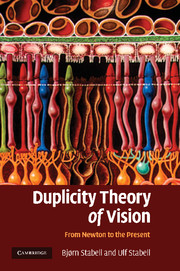Book contents
- Frontmatter
- Contents
- Acknowledgements
- 1 Introduction
- Part I The development of the basic ideas of the duplicity theory from Newton to G. E. Müller
- 2 The Newton tradition
- 3 The Schultze tradition
- 4 The Goethe tradition: the phenomenological approach
- 5 The colour theories of Armin Tschermak and George Elias Müller
- Part II The development of the duplicity theory from 1930–1966
- Part III Chromatic rod vision: a historical account
- Part IV Theories of sensitivity regulation of the rod and cone systems: a historical account
- Part V Factors that triggered the paradigm shifts in the development of the duplicity theory
- References
- Index
2 - The Newton tradition
Published online by Cambridge University Press: 22 January 2010
- Frontmatter
- Contents
- Acknowledgements
- 1 Introduction
- Part I The development of the basic ideas of the duplicity theory from Newton to G. E. Müller
- 2 The Newton tradition
- 3 The Schultze tradition
- 4 The Goethe tradition: the phenomenological approach
- 5 The colour theories of Armin Tschermak and George Elias Müller
- Part II The development of the duplicity theory from 1930–1966
- Part III Chromatic rod vision: a historical account
- Part IV Theories of sensitivity regulation of the rod and cone systems: a historical account
- Part V Factors that triggered the paradigm shifts in the development of the duplicity theory
- References
- Index
Summary
NEWTON'S UNIVERSAL COLOUR THEORY
One major root of the duplicity theory as formulated by Schultze, von Kries and G. E. Müller is represented by the Newton tradition. Within this line of research a rudimentary understanding of the cone mechanisms developed, ending up with the formulation of the famous Young-Helmholtz trichromatic colour theory (Helmholtz, 1867). This theory profoundly influenced Schultze, von Kries and G. E. Müller in their attempt to construct their theories. In fact, the theory forms an integrated part of the duplicity theory and its development may therefore be seen to represent the starting point of the development of the duplicity theory.
Certainly, the development of the trichromatic theory was in many ways initiated by Newton's ingenious experiments and theories on light and colour. In fact, his contribution deserves to be ranked as the first major paradigm shift within vision research in modern times. Surprisingly, however, Newton's revolutionary ideas about light and colour are, today, not generally well known. In the following, therefore, we present his theories in some detail.
Newton's theories were first published 19 February 1672 as a letter in Philosophical Transactions of the Royal Society of London (1671/1672). His most important ideas about light and colour are stated below in his own words. They are given in his propositions 1, 2, 3, 7 and 13 (see also Cohen, 1978, pp. 53–57).
- Type
- Chapter
- Information
- Duplicity Theory of VisionFrom Newton to the Present, pp. 7 - 21Publisher: Cambridge University PressPrint publication year: 2009



